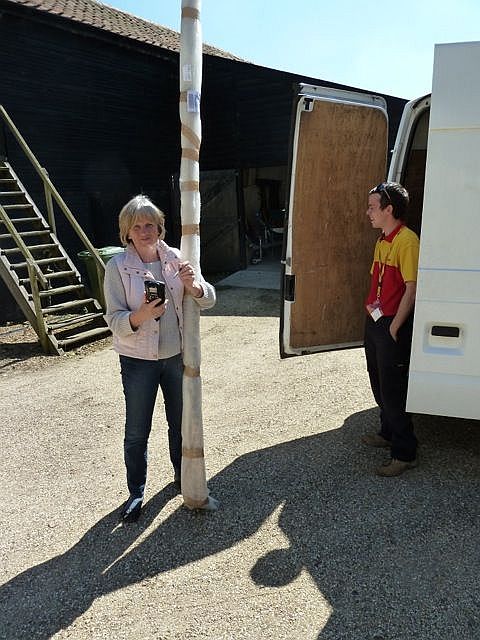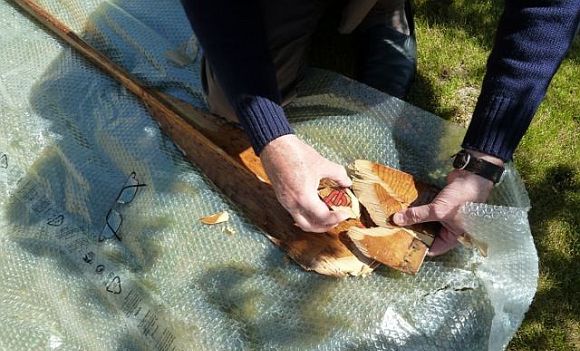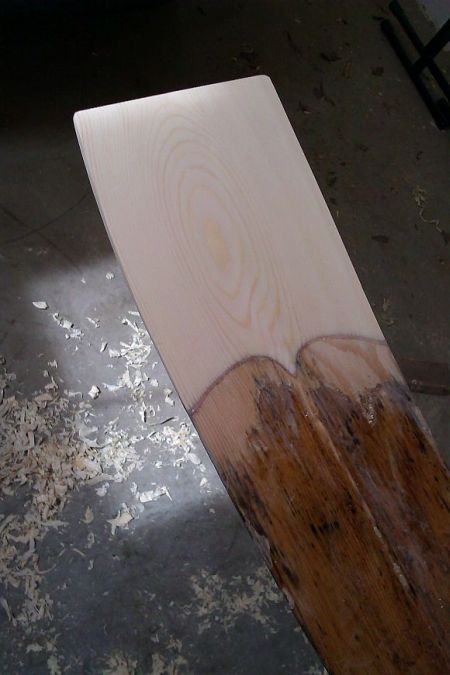Search results
17 results found.
17 results found.
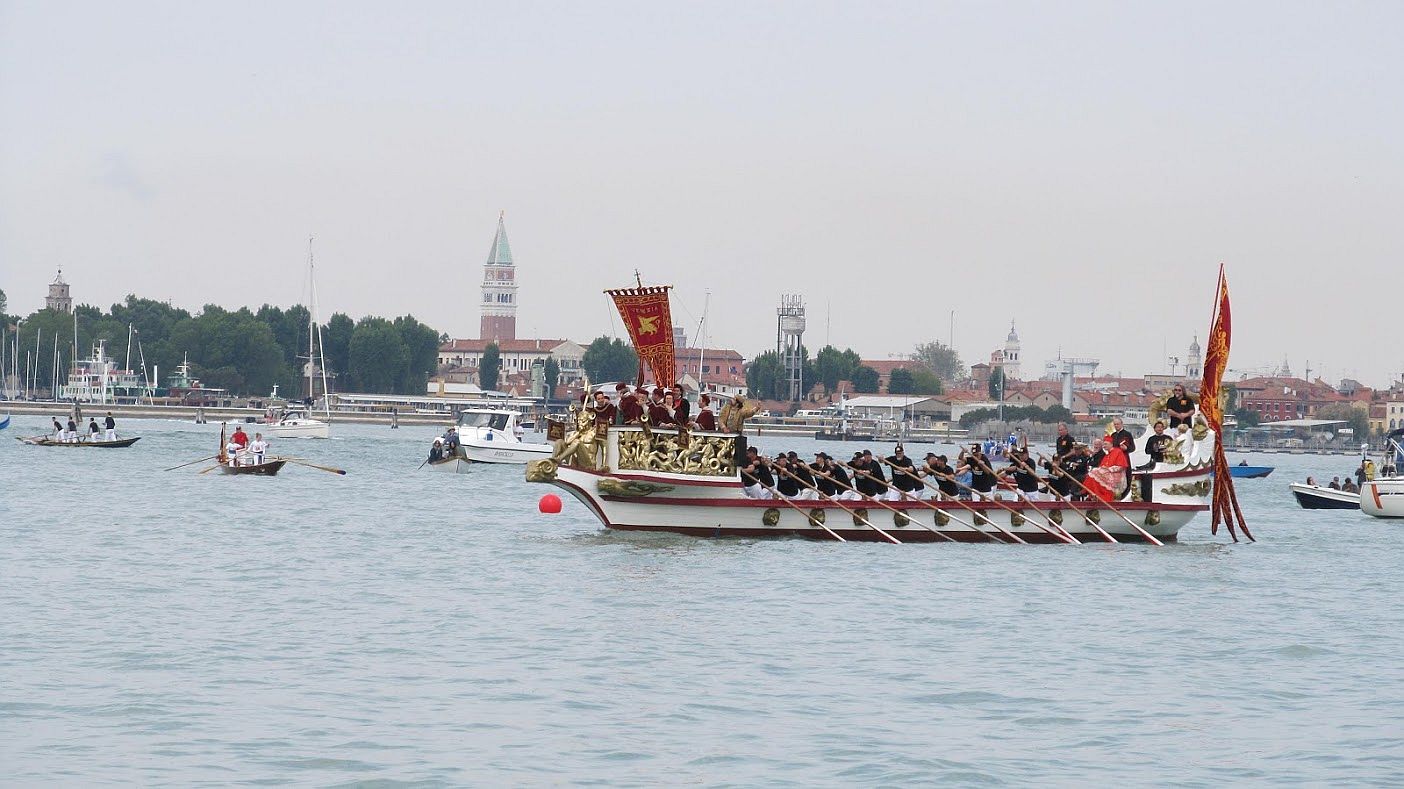

May is a special month to many people, for many reasons. I believe a million poets have made that observation.
For me, the month of roses and gobies and European flounder (there is definitely a poem in there waiting to be lured out), has always been one of the most stressful in the whole year. I would begin dreading May in February, because of two enormous, hence exhausting, annual events that involved Lino and me: the festival of the Sensa (Ascension Day) and the Vogalonga. (“Involved” means planning as well as execution; Lino is part of the Committee of the Sensa, and I would work in the registration office of the Vogalonga for the two weeks leading up to the event.)
Then I would participate in both events — the boat procession, or corteo, for the Sensa, proceeding from Venice to the Lido, and the Vogalonga, which when everything went well would take a good five hours. Things did not always go well; one year it took us seven hours to complete it, due to contrary wind and/or tide, some less-than-prepared rowers in our boat, etc. That’s not a complaint, just a statement. These things happen and you just grit your teeth and carry on. Apart from the rowing itself, we’d see many friends only once a year for the Vogalonga, so any empty spaces in the calendar or the energy of that weekend were filled with convivial (fancy word for “running far into the night”) gatherings in apartments, restaurants, boats, etc.
But this May is abnormal, melancholy, bizarre, because both events have long since been canceled, taking all that annoying confusion, exhaustion, and tension with them. And I’m still not happy! Because this is weird!
The Sensa has been reduced to the commemorative mass at the church of San Nicolo’ on the Lido; it will be attended by the usual personages, but there will be no boats, no tossing of the wreath or the ring, and no races. Why? Because GATHERINGS ARE FORBIDDEN. People would want to GATHER along the shore to watch, and the rowers would certainly be gathered in their boats (forbidden), and the boats would be gathered, and just no.
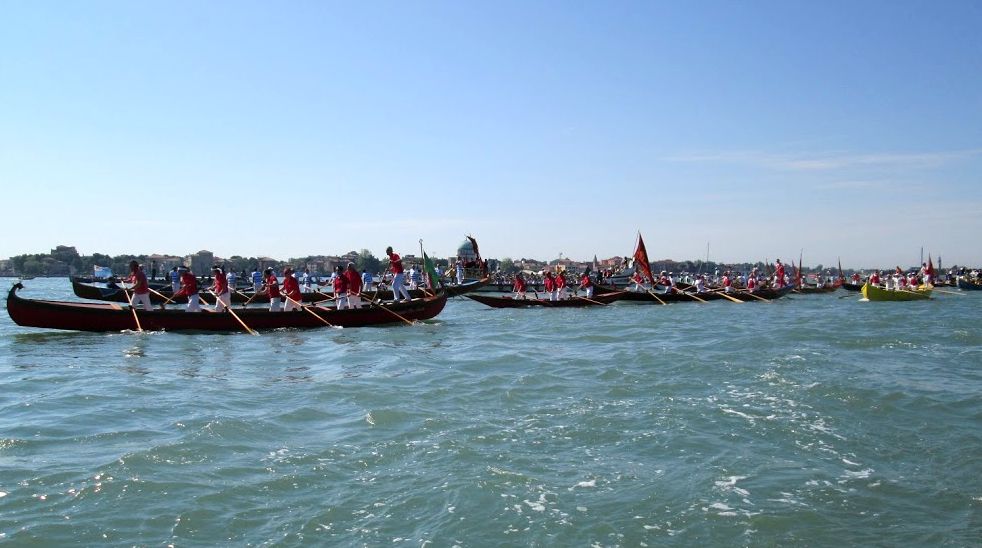
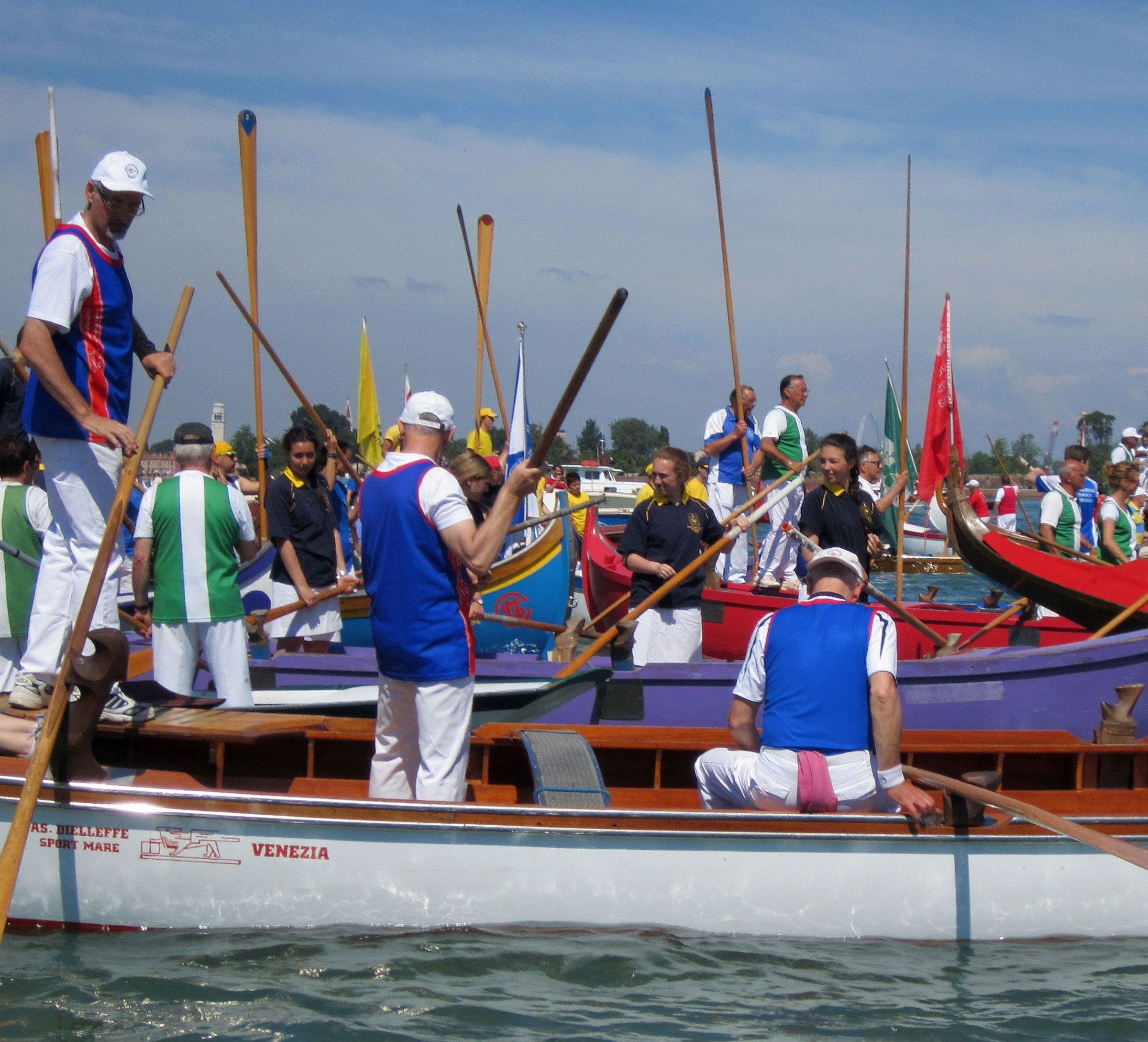
I suppose some private boats could form a procession, each one rowed by the permitted maximum of two people, but that would be even sadder than no boats at all. I told Lino I thought it would extremely cool if every boat club would send their big representative boat, but instead of a full crew each one could be rowed by two people (even the boats that are set up for ten, or 12, or 14 people) or — even better! — rowed by just one person. He said he didn’t think there were that many individuals capable of rowing a big boat by themselves, so there goes that little inspiration. Also, only I have this sort of crackpot idea.
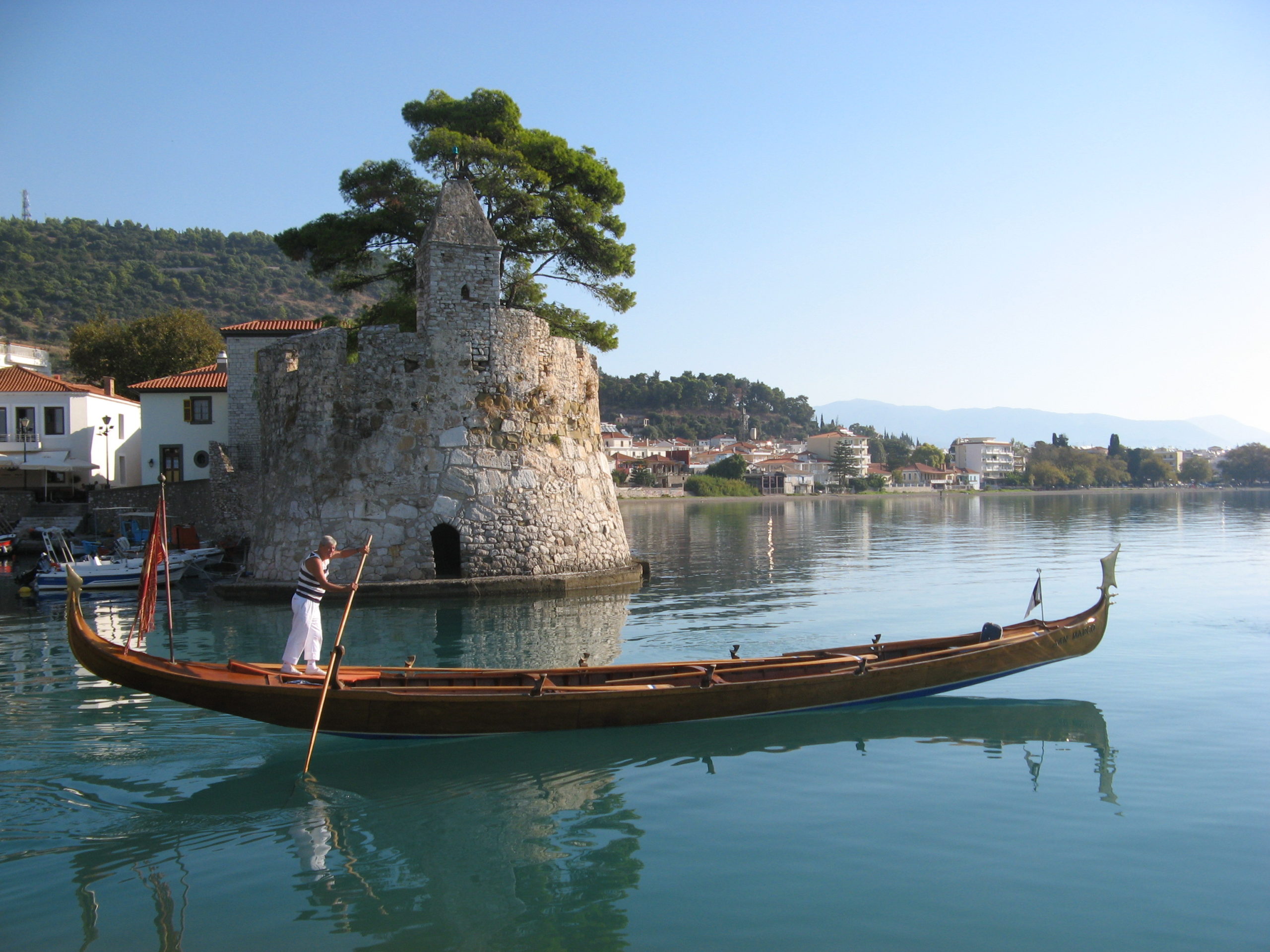
But back to reality. The limitations on rowers would make it impossible to form a corteo. Here is the list of regulations from our boat club; notice that using the boats requires booking a time slot to ensure that only the rowers going out are permitted to even be in the clubhouse. Fine, it was just a fantasy.
“It is forbidden to use the changing rooms and showers in the club. Boats may go out with one rower. Boats with two rowers can go out if they respect the minimum distance of two meters between them in the boat. More than two rowers can go out without respecting the distance requirement EXCLUSIVELY if they are family members who are living together. Use of the mask is OBLIGATORY (worn in the correct manner, that is, covering the mouth and the nose) before and after rowing (one boards and descends from the boat with the mask on). Booking the time of going out and returning will be made EXCLUSIVELY on the WhatsApp group of the club, allowing 20 minutes between exit and return time in order to avoid meetings (overlapping, running into other people, however you want to put it) in the clubhouse. If on return you find that another boat is preparing to exit the club, wait at a distance till the other boat has departed. Seeing the situation, to guarantee the safety and health of all members, the Council of Directors will look at the recorded videos to ensure that all the members respect these rules. Anyone who goes out MUST, on return, wash the club’s boat and oars with water and bleach-based soap provided in the club.”
The Vogalonga — this year would have been the 46th — was scheduled, as always, a week after the Sensa — May 31, to be precise. It has never been canceled, even in the worst weather. A pandemic is clearly so much worse than weather. Besides, no one can travel, the hotels are closed, and just to review the basics: Gatherings of people are forbidden. If some 2000 boats in the water don’t constitute a gathering, then we need a new definition.
So the two big events that made May matter have been expunged and left only its husk ready to fall off the calendar just like March and April have already done. What an ignoble end to a once-princely month.
Happily, spring is proceeding with its usual nonchalance, bestowing any number of special gifts (do they still qualify as gifts if you count on getting them every year?). Blackbirds singing at dawn and at sunset, the limetrees just beginning to waft their delicate perfume along viale Garibaldi, the first magnolia on the tree next to General Emo Capodilista. The signs of the season haven’t failed us.
And we’re well underway with the artichokes (their moment is almost over), and fresh peas and asparagus. The fruit is in that awkward stage between winter and summer — we’re bored to death with apples and bananas, but the first cherries are expensive and flavorless, the apricots should be ashamed of pushing themselves forward so aggressively because they are definitely not ready yet, and some vendors are offering melons, for Lord’s sake. Everybody knows that melons were put on this earth to save your life in July and August; in May you might as well just sell photos of melons, the taste would be the same.
Fish, however, are having their moment. “Quando la rosa mette spin’, xe bon el go’ e el passarin.” When the rose puts out its thorns, the gobie and the flounder are good. Seppie belong in this category too, but it doesn’t rhyme.
Lino, who has fished all year long all his life, tells me this: “The go’ are always in the lagoon. The passarini lay their eggs in December and go out into the Adriatic; they come back in between March and April. The seppie begin to come into the lagoon in March. In May and June the gilthead bream, striped seabream and sea bass come in to lay their eggs….” I know things are proceeding according to plan because we have seen little swarms of fingerlings in the canal several times.
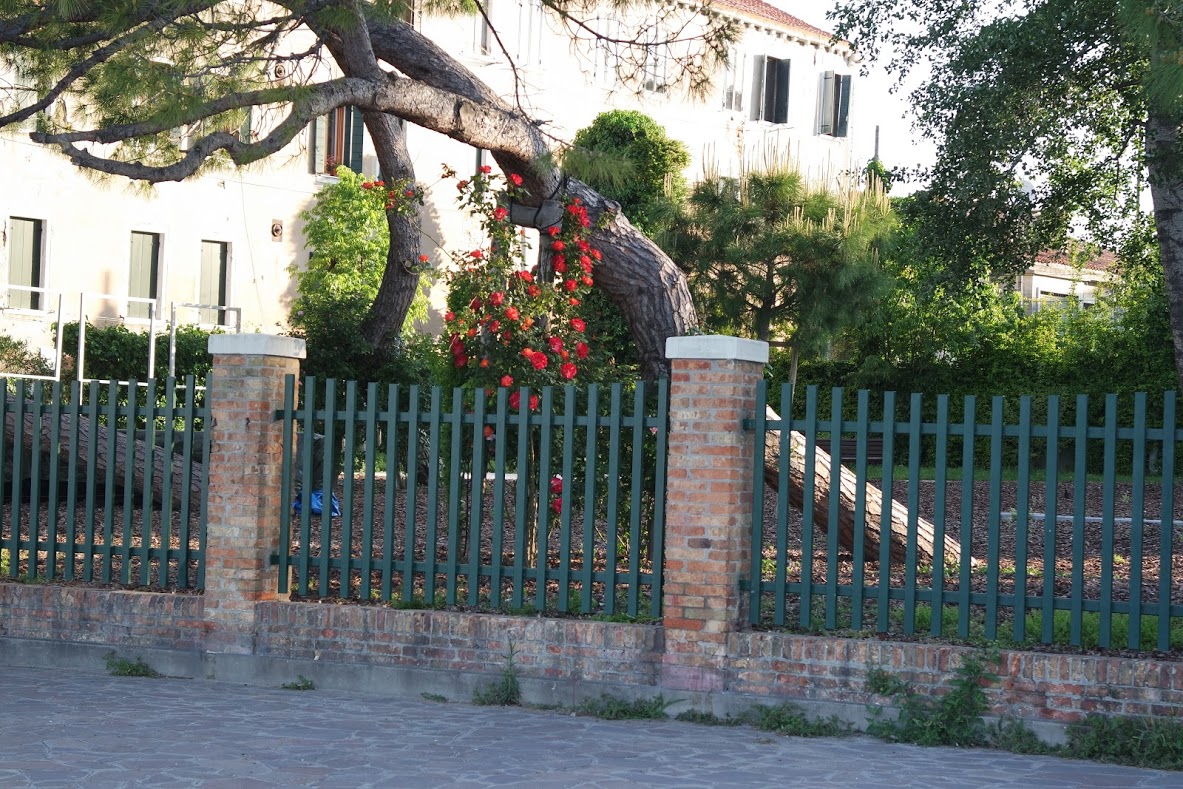
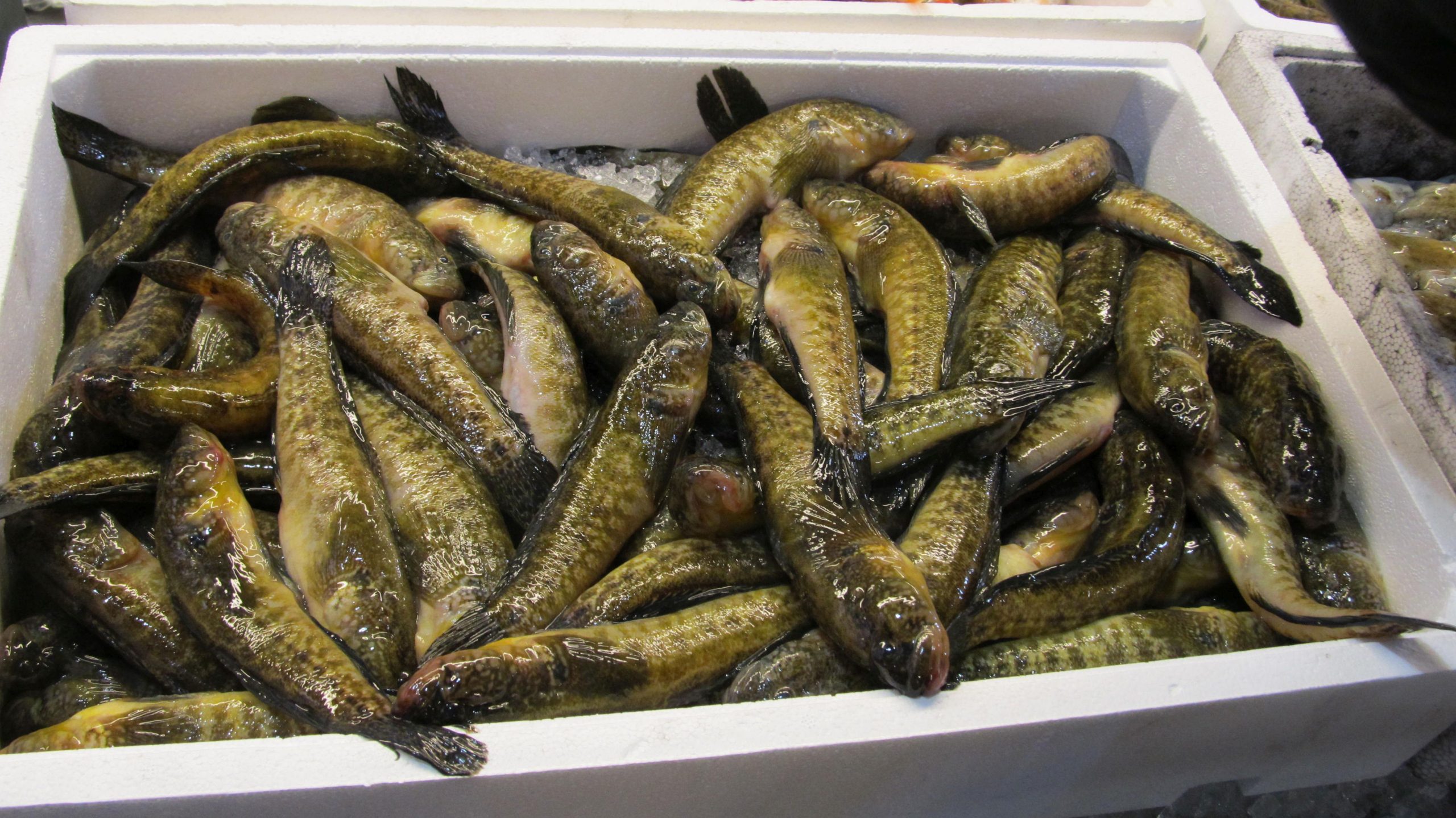
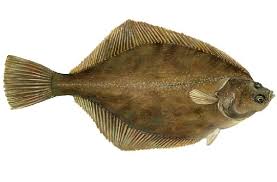
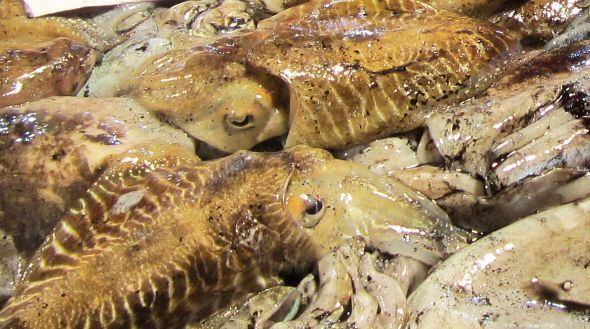
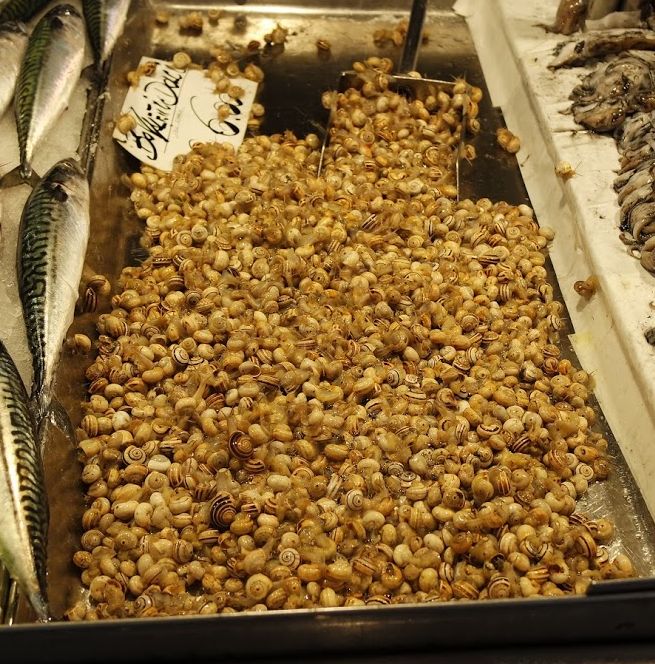
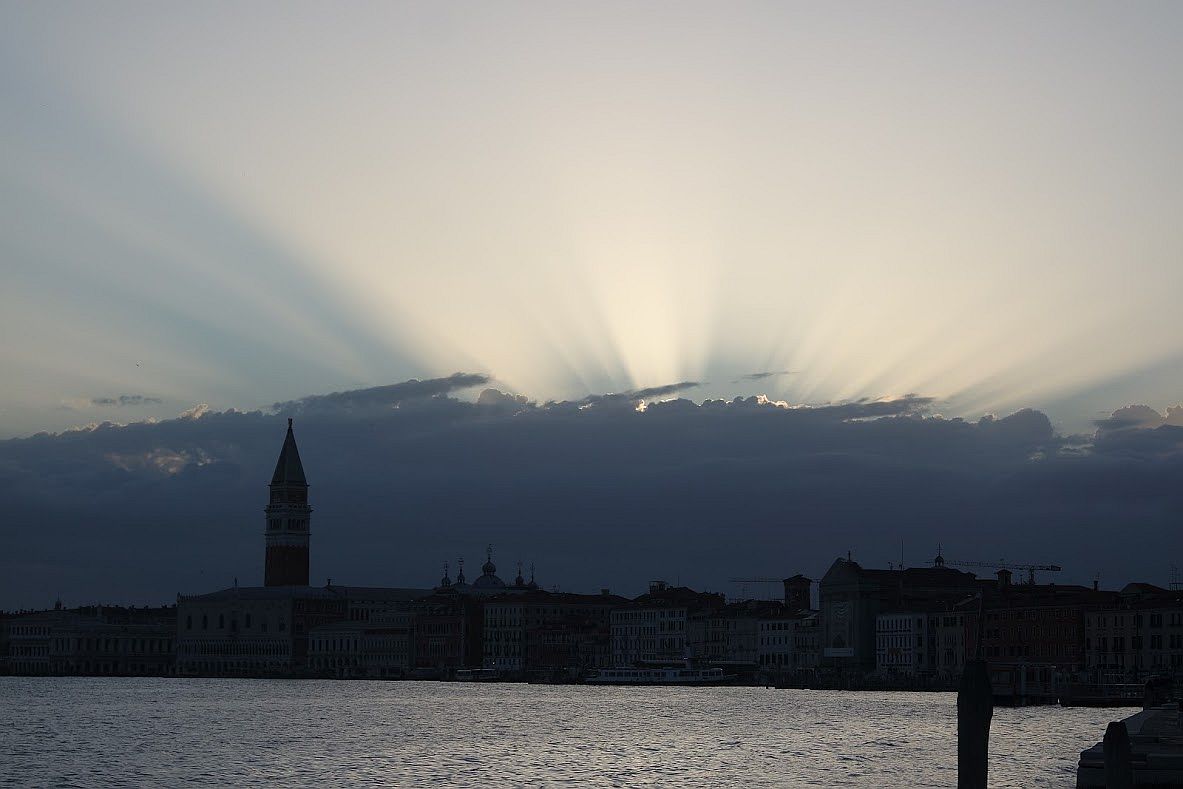
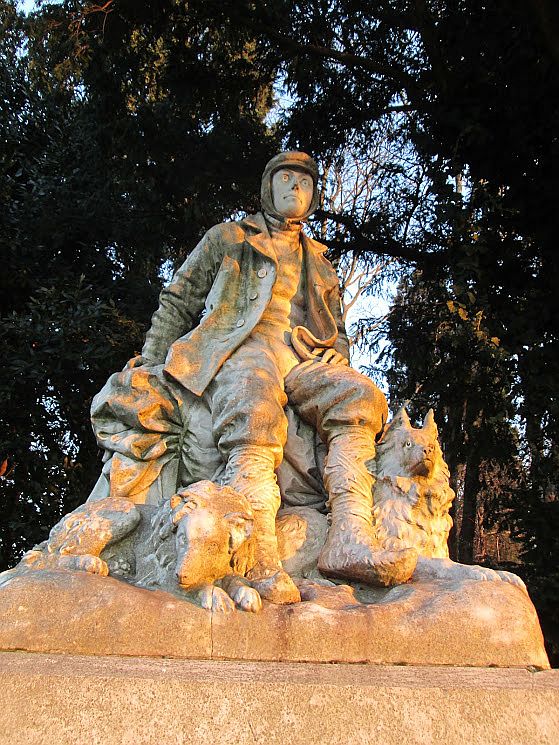
Francesco Querini isn’t exactly forgotten, even if the inscription on his monument has become totally illegible, but the casual passerby has no way of identifying him. He’s hard to miss, though, considering that his statue has a front-row seat in the Gardens, and he makes quite an impression — in Venice one certainly doesn’t expect to see a man in Arctic gear with his huskies, staring at the horizon.
No, he did not bring the serum to Nome. I suppose he could have, but he had been dead for 24 years by then. Oh wait — we don’t actually know when he died. We only know when he was last seen: March 23, 1900. So basically he’s famous not for what he did, but for what he didn’t do: Make it home safe from the North Pole.
Querini was born on December 16, 1867, a member of the San Silvestro branch of one of Venice’s most illustrious and ancient families; he was also a decorated naval officer, and a scientist. He spoke English, French and German perfectly, and he was up to speed in Latin, though it probably wasn’t something he often needed in conversation. He was prepared for many things in life, but he wanted more than what even the most eventful naval career could offer.
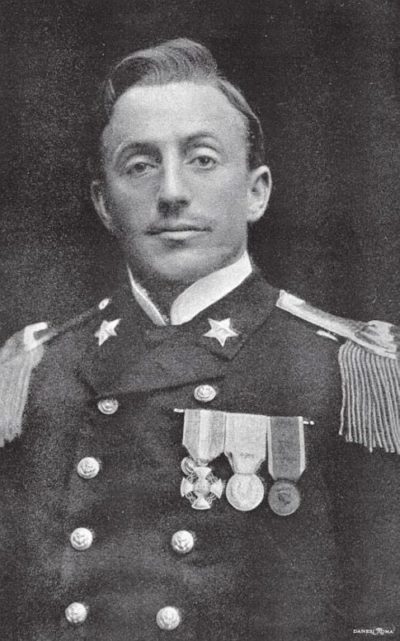
In 1899 Prince Luigi Amedeo of Savoia-Aosta, duke of the Abruzzi, organized an expedition to the North Pole, and asked Querini to join; his responsibilities were to be the collection of minerals and acting as the right-hand man of Captain Umberto Cagni (KAN-yee) for the scientific observations.
This may not sound like anything impressive today, but theirs was the latest in an already long series of efforts to certifiably reach the North Pole. It had become something of an international competition.
The immediately preceding attempt had been Nansen and Johansen in April 1895, who reached latitude 86°14′ North on skis before they turned back. Each expedition was getting closer to the goal, and the duke, already famous for his extreme adventures, was determined to be the one to get there.
The group of 21 members departed from Archangel on July 12, 1899 aboard the revised whaling ship “Stella Polare,” and in the course of the expedition various members suffered the usual Arctic horrors, from frostbite to amputations to their eyes freezing shut. On March 11, 1900, after the long winter in the ship preparing for the assault, and a failed first start, it was off for the Pole.
Ten men were divided into three sections. The duke had to stay in camp due to slow recovery from the aforementioned amputation (of two frozen fingers). Cagni had three men, Cavalli Molinelli had two men, and Querini had two men. I don’t know how the 104 sled dogs and ten sleds were apportioned.
The temperature dropped to -53 degrees C (-63 F) but worse than the cold were the ridges. Colliding ice floes often create ridges, and progress was much slower than the men had anticipated (four kilometers in 12 hours, or 33 meters/100 feet per hour, or a little more than one foot per minute). Supplies began to dwindle, and after 12 days of struggle forward it was clear that there wouldn’t be enough food for everybody to reach the Pole and return.
On March 23, 1900 Cagni ordered Querini and his men to turn back toward base, and shortly thereafter Cavalli also headed back. Cavalli made it, after 24 days of trekking, and Cagni also made it after a harrowing two solid months (subtracting dogs and abandoning equipment along the way). But Querini and his two intrepid companions, Felice Ollier (a mountain guide from the Val d’Aosta, 30 years old) and first macchinista* Enrico Alfredo Stokken (Norwegian, 24 years old, who had asked to be taken along), were never seen again.

Cagni’s four-man squad had reached latitude 86°34′ on 25 April — Saint Mark’s day! — setting a new record by beating Nansen’s result by 35 to 40 km (22 to 25 miles), stopping at about 382 km/237 miles short of the Pole. I’d like the fact to sink in that an Italian team established a polar record that stood until May 12, 1926, when Amundsen and another Italian, Umberto Nobile, verifiably attained the Pole. More about them in the next installment.
Naturally the whole expedition was aghast at Querini’s disappearance. The duke organized a search party that went east for 12 days. But by August 16 the group decided they finally had to depart, and the “Stella Polare” weighed anchor from its harbor on Prince Rudolf Island. They left abundant provisions of every kind, as well as eight dogs (and food for same), plus a small boat, and shaped their course for Norway.
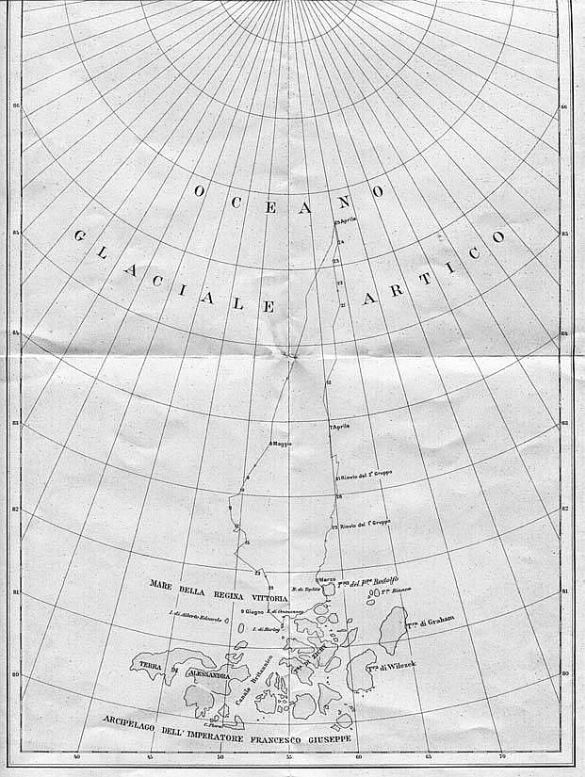
Does it seem strange that somebody could just disappear? It’s strange that it didn’t happen more often, up there surrounded by several million square kilometers of empty white.
They were walking on ice, which tends to form in ridges, “small ‘mountain ranges’ that form on top of the ice…that can easily be two meters/six feet or higher,” states the National Snow and Ice Data Center. “Ridges create significant obstacles to anyone trying to traverse the ice. One usually encounters 4 or 5 pressure ridges per kilometer, but the number may rise to 30 per kilometer in places.”

Furthermore, the ice is floating. Setting aside the dread danger of “leads,” or water breaking open between the stretches of ice, the men were trudging across floes that were subject to four forces: “Wind drag, water drag (current), Coriolis force (a force resulting from the earth’s rotation, which acts at right angles to the velocity vector of the ice …), and lateral forces resulting from the pressure of the surrounding ice floes,” as explained in “The Physics of Ice.” ” The earth is rotating from west to east. If the forces of wind and current move the floe to the south… the floe tends to lag, and acts as if a force were pushing it westward.” The motion of the ice was one reason Cagni’s team took two months to make it back, as whole days were lost as the men walked forward on ice which was moving backward.
As Querini’s fate was reluctantly accepted, the memorials began to appear.
In November of 1900, the Italian Geographic Society awarded its silver medal to “the Hero fallen in one of the most arduous battles of science.” Dramatic as their race to the Pole was, the men were also pursuing important research, among which were the exact determination of the oceanic circulation, the location of the magnetic pole and its influence, light phenomena in the polar night, the thermal economy of the atmosphere and the Arctic seas, the formation and drift of the ice, the force of gravity, and measuring the depression of the planet toward the North Pole.
Early in 1901, the city of Venice advertised a large reward to anyone able to give news of the men. On May 22, 1901, Count Filippo Grimani, mayor of Venice, bestowed on Querini’s father, Nunzio, a gold medal as a token of “the city’s sentiment toward the memory of his son.”
On May 16, 1901, Count Piero Foscari met with 20 dissatisfied members of the Royal Rowing Society Bucintoro and founded a new rowing club named in honor of his lost friend: the Royal Rowing Society Francesco Querini.
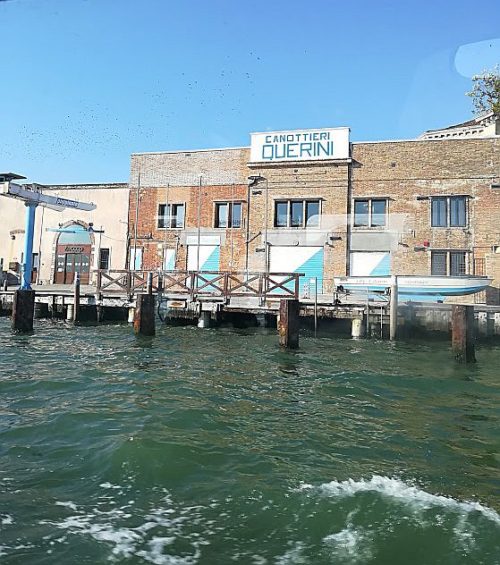
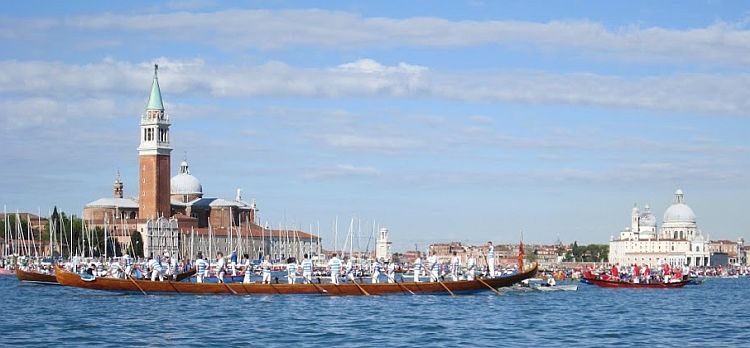
Refusing to abandon all hope, even after frequent questioning of whaling crews brought no information, the duke sent a ship to Franz Josef Land in the summer of 1901, commanded by the father of machinist Stokken. They too returned with no news whatever.
In May of 1903, the Italian Navy sent the family a medal honoring all the members of the expedition.
On October 12, 1903, the city council of Venice unanimously approved the commissioning of a monument to Querini (the famous statue), to which the duke of the Abruzzi contributed 10,000 lire (this was only slightly more than the annual salary of an upper-echelon civil servant). It also voted to establish a scholarship in Querini’s honor for the sons of Venetian seamen or military officers applying to the Naval Academy at Livorno.
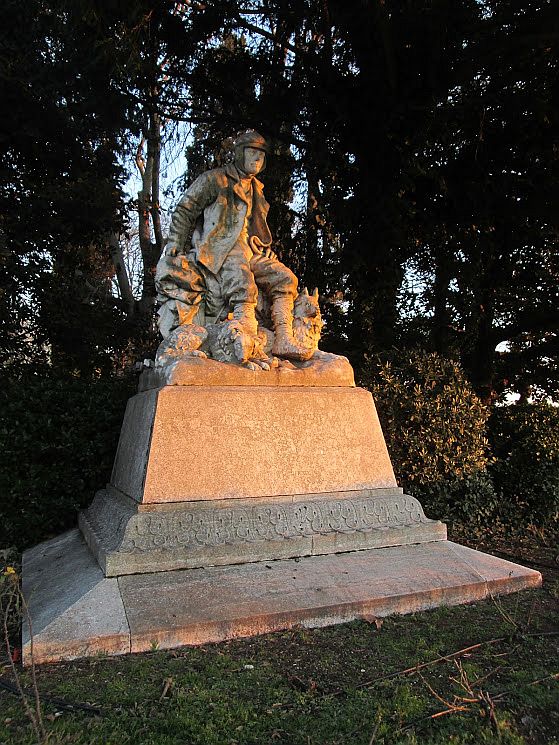
It is reported that a further phrase was incised — if it was on the pedestal, it also has disappeared — to honor Querini’s comrades. It said “A PERENNE MEMORIA / SI SCRIVONO QUI I NOMI / DEGLI ALTRI DUE COMPAGNI PERITI NELLA SPEDIZIONE / ENRICO ALFREDO STOKKEN 1 MACCHINISTA / FELICE OLLIER GUIDA.” “In perpetual memory / are written here the names / of the other two companions who perished in the expedition / Enrico Alfredo Stokken first macchinista / Felice Ollier guide.”
For the record, there is a monument to Felice Ollier in Courmayeur in the Val d’Aosta, also offered by the duke. I have yet to locate any mention of a memorial to Enrico Alfredo Stokken.
One doesn’t want to imagine Querini’s last days, or at what point he and his companions realized it was over, or when it actually was over for the last of them. Did they starve? Freeze? Drown? Were they killed by polar bears? It seems as if they simply evaporated, and I, for one, profoundly wish that could have been true.

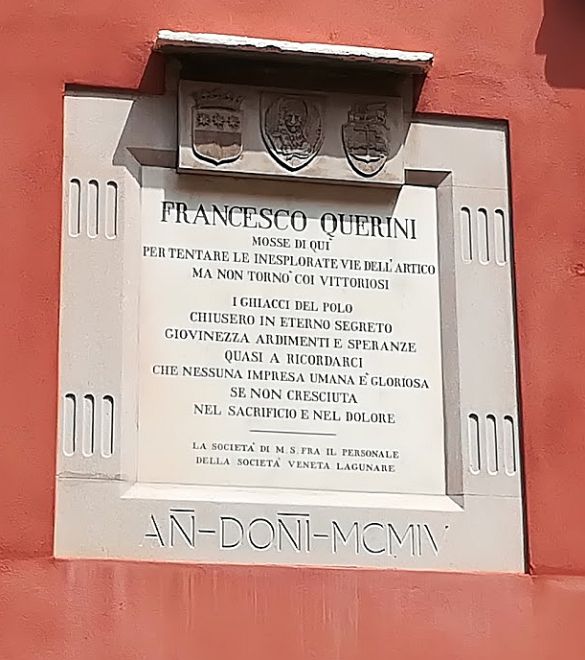
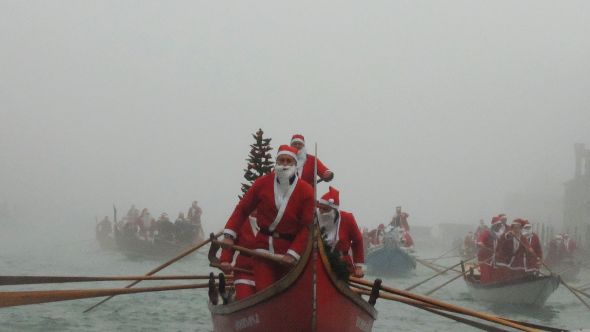
Before we leave the subject and the scales and bones and gift-wrapping of Christmas behind, one last glimpse of holiday merriment. I wasn’t there, I’m sorry to say — I was sorry to say it the day it occurred, too, which was December 21.
The event: A “corteo,” or boat procession, in the Grand Canal, composed of anyone who wanted to row as long as he or she was dressed as Santa Claus (or “Babbo Natale,” as he’s known here).
The reason: First, because it seemed like a fun thing to do. Second, because it seemed like an amusing occasion for the Coordinamento delle Remiere (the association of rowing clubs) to give a prize and a big round of applause to the dwindling group of hardy souls who have rowed in all 40 Vogalongas. I say “dwindling” because in May there were 24 such persons, and on Santa Sunday there were 22.
The special bonus: Fog. Fog and just enough wind to make the air feel even sharper. But would this deter anyone willing to pull out the boat and pull on the red-and-white outfit? Obviously not.
Because I was busy elsewhere, Lino armed a modest sandolo and headed for the lineup joined (happily for Lino and I think also happily for the others) by Gabriele De Mattia, a former rowing student of his and ex-cadet of the Francesco Morosini Naval School, and his girlfriend, Francesca Rosso. She had never rowed before, but Lino soon took care of that.
So the three of them spent the morning rowing, and Lino was awarded a red pennant, such as those given to the winners of races here, with his name on it, and everybody was happy. Especially when the sun finally came out.
So a big shout-out to Francesca, who when she wasn’t rowing, was taking pictures. If she hadn’t been there, you all would just have had to imagine it. As would I. This is better.
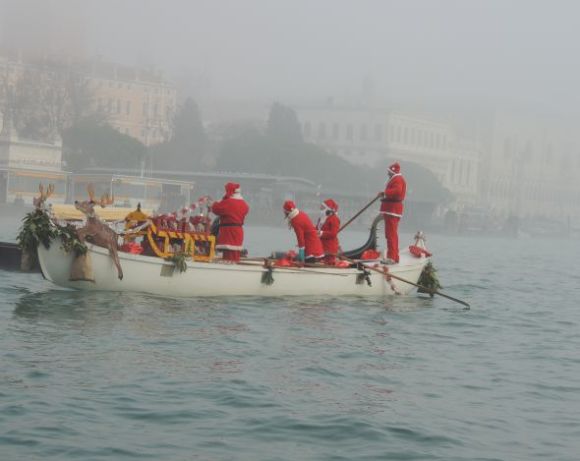

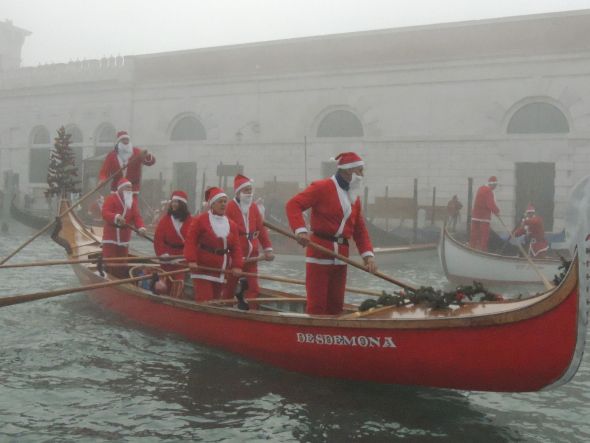
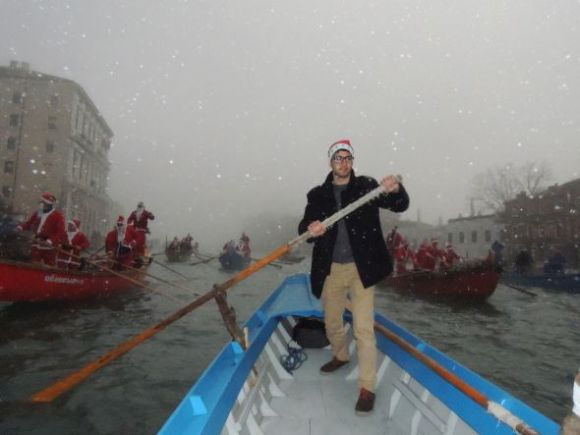
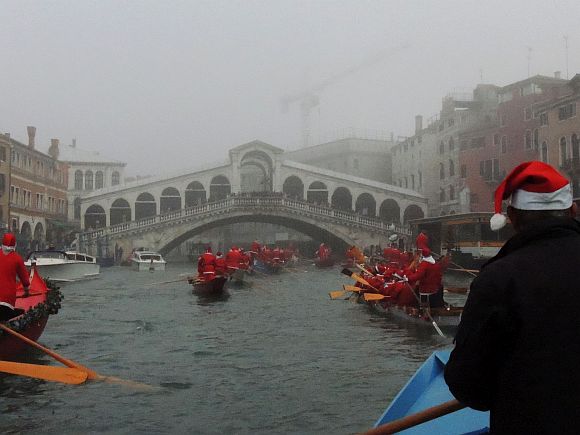
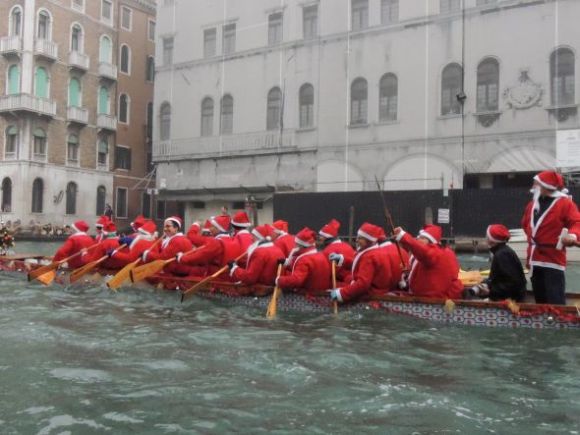
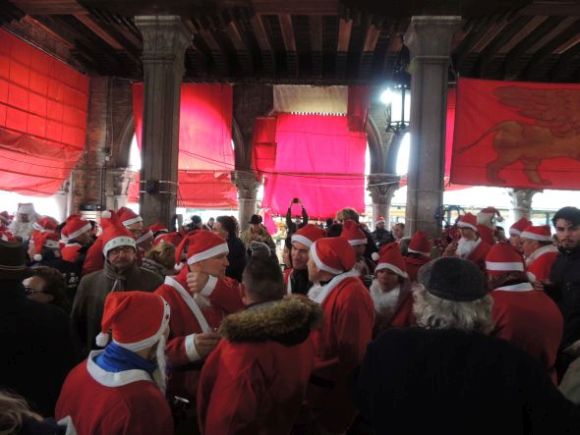
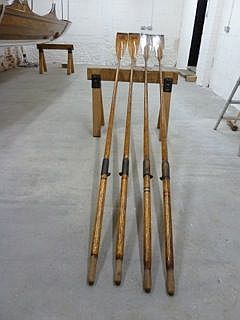
I toil for two weeks every May in the registration office of the Vogalonga. And every year, something interesting occurs. This year, that “something” was more than usually diverting. It had to do with the search and rescue of a foreign oar.
Everything started with an e-mail a week before the event, sent to the office from an English rower, Dr. Adrian Hodge; he was planning to come with his Thames skiff, “Cherub,” and a group from his rowing club (Norfolk Skiff Club). As it was the first time they were undertaking this little quadrille, he wanted information on the parking and boat-launching facilities, which I took it upon myself to supply, along with a batch of my usual unsolicited observations and comments, no extra charge.
Technical digression: “Cherub” is 8 meters/26 feet long, is said to date from the 1890s, and was built at Richmond on Thames. Unfortunately all the records of the company which built her were destroyed when the boat yard was sold in the 1960s, so Adrian doesn’t know who was the original owner.
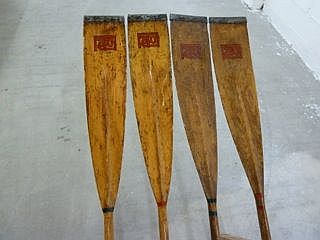
So they came, they rowed the Vogalonga, they pulled “Cherub” out of the water, loaded it on the trailer, drove the 1,700 km (1,056 miles) home to Norfolk, and unloaded the boat.
Following is a highly condensed version of the most pertinent of the numerous e-mails that ensued.
Dear Erla,
The journey back to England was uneventful, apart from the weather, and I have just inspected the skiff to make sure that she had returned unscathed. To my horror I discovered that we have lost a scull (oar). A moment’s thought and I remembered that we had used a scull to position the lifting strops for the crane on Monday. I suppose that someone put it down on the ground and we simply left it behind. It was beside the orange painted fixed crane and Michele was in charge of the crane team. I’m sorry to lose it because it is antique and carries the monogram of a previous owner of the boat, so, if you have the opportunity to put the word around, and if it turns up, keep it somewhere and I hope that it can be repatriated next year. I’m sending you a picture too, so that if you see it decorating a bar, you will know where it came from! Since the photos it has lost its copper end and had some repairs to the tip.
Although I dislike disasters, I do enjoy a challenge, so I leapt into action.
Dear Adrian:
I have spoken with the organizers of the Vogalonga and they say they know nothing, and have heard nothing, about your oar.
However, they did suggest that you tell me where you took the boat out of the water. If you would tell me this detail, I will attempt to contact whoever is responsible for that area.
He replied: We lifted the boat out at the quay just before the bridge to Tronchetto. There were three cranes and we used the centre one which was painted orange and had Scalo Fluviale and a number 2 on it. Michele was in charge. He was driving the forklift truck.
I called the Scalo Fluviale, and they knew all about the oar. “Sure, we have it,” they told me. Why should there be panic, stress, visions of mayhem? “It’s right here.”
OAR FOUND!!!! I e-mailed Adrian. I love good news, especially when it’s unexpected.
You are incomparable, he replied. (I liked that bit.) My prayers to St. Anthony of Padua have been answered. My next plan was to get some real Catholics to pray to him too.
On the practical front, the oar is 290cm (9.5 feet) long and weighs 2.0 kg (in fact, a bit less). Normal parcel post is restricted to 1.5 meters (4.9 feet). I think that the most practical method will be for me to fly out and collect it, but first I must make sure the airline will carry it and that I can get it to the airport.
That was an interesting aspect of the project. How was that going to work? Simple: It wasn’t, as Adrian quickly discovered.
The airlines put it in the same category as a vaulting pole and won’t carry it. (I haven’t found time yet to satisfy my newfound curiosity about how vaulting poles make it from home to the Olympics.) DHL will carry items up to 300 cm long, so that must be the default method. I can fly to Venice Tuesday morning, collect the item, wrap it, and deliver it to a DHL collection point, then fly back Tuesday evening.
The day before his arrival, I went to the Scalo Fluviale to locate the oar. There it was, propped against the office wall, looking pensive.
Some phone calls had already revealed that the nearest DHL collection point was at Piazzale Roma, a mere few minutes away. This was another happy surprise; I had had nightmare visions of some storefront in the heart of darkest Mestre. I went by to check on the details of the consignment. On the way home and I bought an exaggerated amount of bubblewrap (nightmare visions of coming up two inches short); unfortunately the bubbles were small, but there was no alternative. I wasn’t up to rigging a splint, and figured if we used enough (but not so much as to exceed the length limit), it ought to work.
Yes, I had become “we.”
Tuesday morning I went to Piazzale Roma to meet Adrian and his wife, Lynne, as they got off the bus from Treviso airport (sure, let’s add another hour and ten minutes each way to the day’s schedule…).

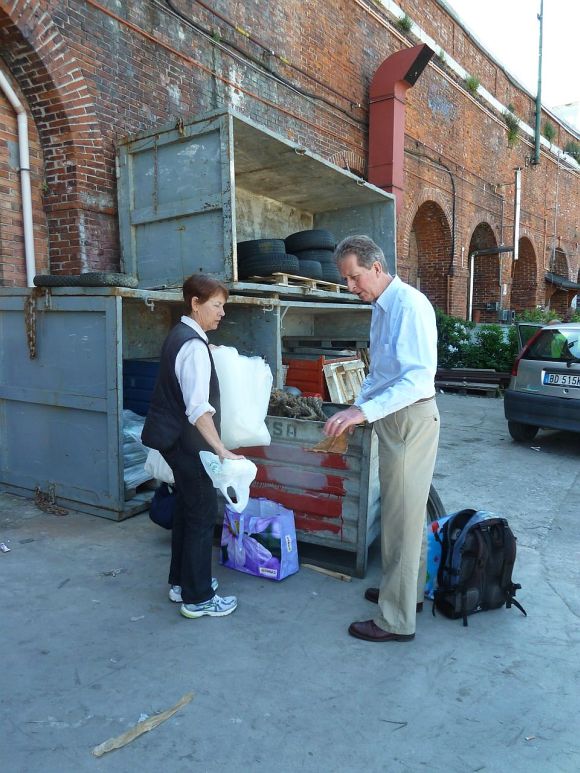
We walked to the Scalo Fluviale; the oar was brought out, we wrapped it, we distributed bottles of wine dripping with gratitude to all and sundry (for the record, it was Enrico who had found the oar). We carried the oar, like some titanic assegai, back to Piazzale Roma and the DHL office, where we created a moment of consternation.
Paperwork completed, payment made, oar consigned, deep sighs of relief and satisfaction breathed, we went to a nearby trattoria where Adrian and Lynne treated me to a sumptuous and princely lunch.
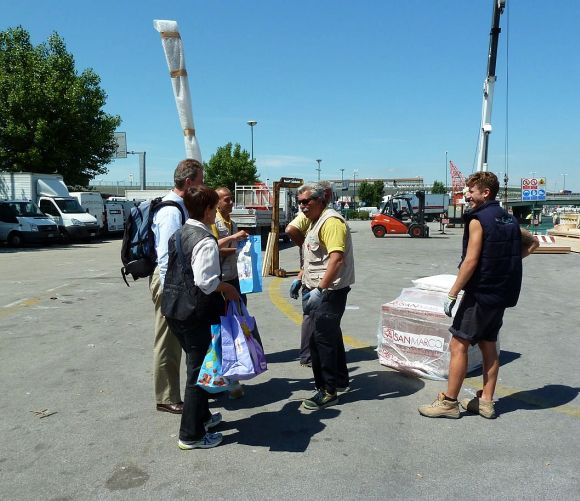
But hold the happily-ever-after. “We must expect reverses, even defeats,” Robert E. Lee remarked, though not to us personally. “They are sent to teach us wisdom and prudence, to call forth greater energies, and to prevent our falling into greater disasters.” I’ll make a note of it, because…..
The oar arrived at 3:15, Adrian e-mailed me, but the end, complete with monogram, was smashed to pieces. I tried to fit it together like a jigsaw, but the wood was crushed too much….It must have been crushed under something heavy, because the wood is deformed. I can’t save this limb and must amputate. I’ll make a sloping cut straight across where the wood is sound and glue on a new piece of wood. Then I’ll shape a new end. Many oars are made like that from new. Unfortunately the monogram will be lost. I’m debating with myself whether to fake that. In general my policy is one of honest repair rather than renovation, preserving as much of the original as possible, but clearly showing any new material.
Adrian is currently involved in some other, more urgent projects, so I haven’t seen the final version yet. But as any pulverized oar will tell you, the worst is clearly over.
I guess now you could say we’re at happily-ever-after. In any case, the adventure has been immortalized in a clip which is on the club’s website (and on YouTube) — set to the tune of the irrepressible Jimmy Durante singing “The Guy Who Found the Lost Chord.” For e-mail readers, here’s the link: http://www.youtube.com/watch?feature=player_embedded&v=Kby8OYXyUtQ
